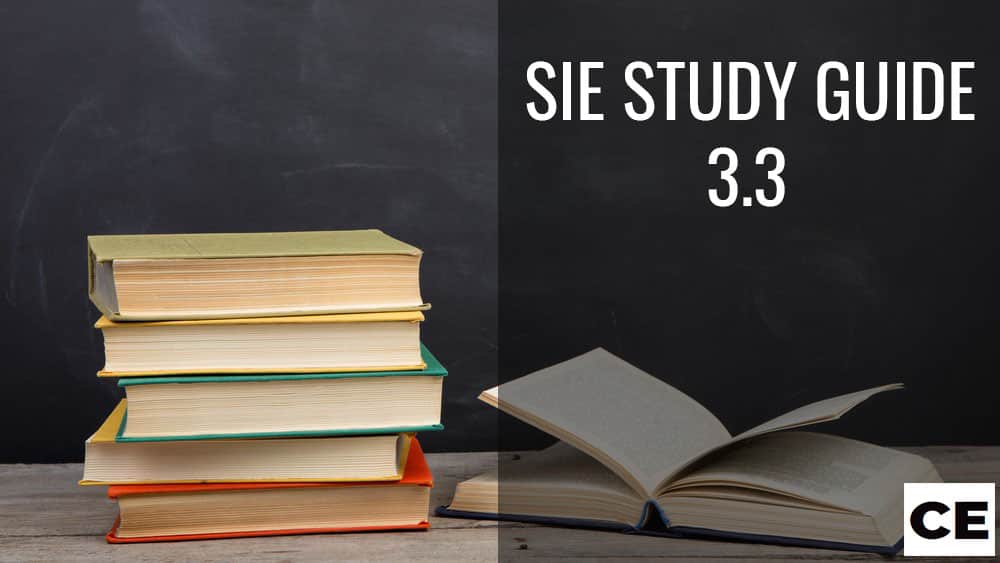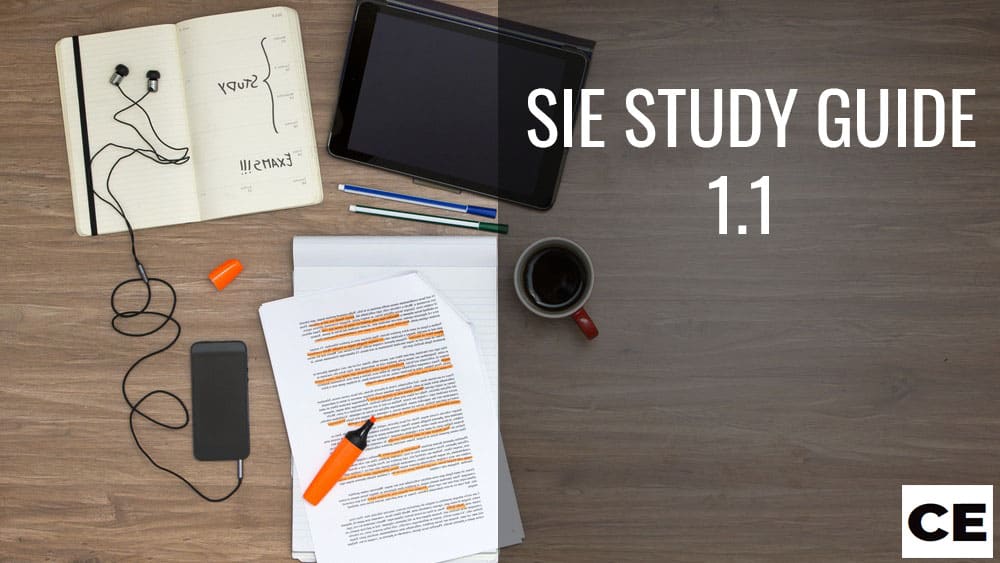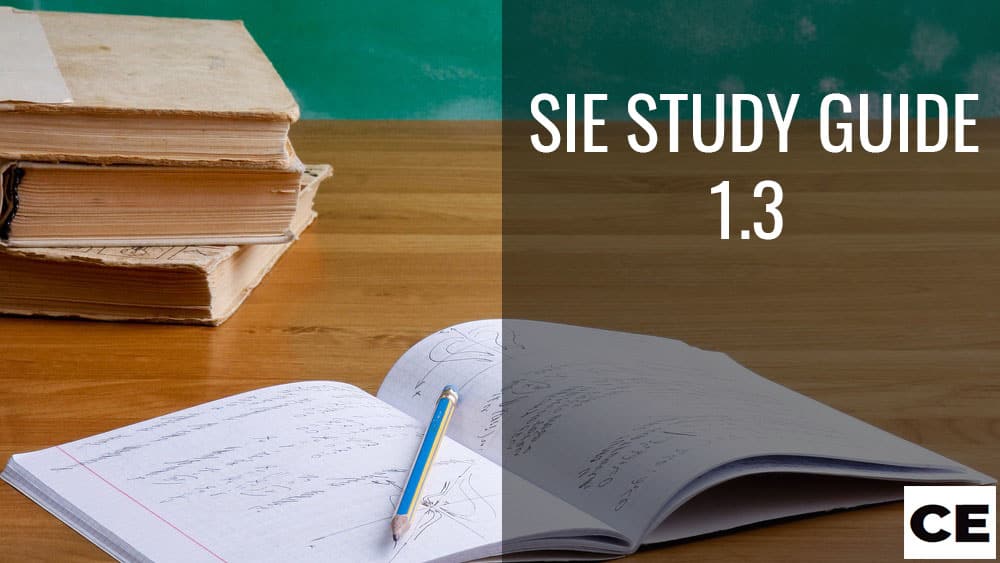SIE Study Guide Navigation
- SIE Study Guide Home
- 1.1 Regulatory organizations, establishments and participants in the capital market
- 1.2 Structure of capital markets
- 1.3 Understanding economic factors
- 1.4 Types of security offerings
- 2.1 Securities products in capital markets
- 2.2 Various types of investment risk
- 3.1 Settlement, trading, and corporate actions
- 3.2 Compliance considerations and customer accounts
- 3.3 Prohibited activities
- 4.1 Associated persons SRO regulatory requirements
- 4.2 Reportable events and employee conduct
There are various types of brokerage accounts that can be registered with customers.
3.2.1 Different account types and their characteristics
Let’s look at those you need to know about.
Cash accounts
In the world of investing, a cash account most basic account available and it’s available for anyone to open.
Purchase of any securities must be paid in full to secure them too.
That means payment must be made on the agreed-upon settlement date by the close of business.
Usually, this is T+2, the second business day and this is known as regular way settlement.
Accounts with contribution limits, for example, IRAs, must be opened as cash accounts.
Margin accounts
With a margin account, a brokerage can finance purchases for a client and up to 50% of the purchase value may be lent to them.
In trading terms, this is called buying on margin and means that customers can increase their trading capital significantly.
As soon as the client sells or liquidates those securities, the loan has to be repaid.
Margin accounts come in two types: long and short.
With a long margin account, interest is paid on the money borrowed to purchase securities.
A short margin account differs in the fact that borrowed stock is sold short.
As its value declines a customer will profit.
Short sales must be able to be accounted for in a margin account.
Borrowed stock for short sales can come from many sources.
The most obvious is the firm through which the short sale will be executed.
Other options include margin customers of the member firm, other member firms, institutional investors, or specialized stock lending firms.
Of these, the margin account of other customers is the most popular option and that’s because they offer certain advantages.
- With a lower initial cash outlay, more securities can be bought
- Through borrowing some of the purchase price, the investment is leveraged
The rate of return for a customer – or the rate of loss in poor market conditions – is magnified through leveraging.
Options accounts
To open an options account, an investor must first complete an options agreement with the broker-dealer.
This helps to show that they have investing knowledge and understand not only the risks associated with options transactions but also how they work as well as trading strategies.
Part of this process includes providing additional information.
This is linked to their overall objectives for investing, their experience in trading as well as personal financial details.
Broker-dealers will need to provide various disclosures as well.
Once all of this is completed and based on the answers given, the broker-dealer decides on one of five option trading levels the investor qualifies for.
Discretionary vs Non-discretionary accounts
We’ve covered this earlier but it’s important to recap, especially in this section
A discretionary account sees clients allow their brokers to trade on their behalf while a non-discretionary account is the opposite.
Here, the investor themselves tells the broker what trades they want to make.
Of course, the broker is allowed to provide advice but must follow through on what the client wants.
Commission-based v Fee-based
This doesn’t necessarily relate to accounts but to the investment advisor that investors chose to help them with their investments.
Those who are fee-based charge for their time.
This can be a flat fee or annually, hourly, or per month.
Fee-based advisors act under fiduciary duty and always have their client’s best interests in mind when dealing with them.
Those who are commission-based will sell investment products to their clients or open various accounts needed for investment for them.
While some do operate under a fiduciary duty, this is optional.
3.2.2 Registrations – Customer Accounts
There are a number of accounts that we need to cover under registration.
Individual account
An account opened for a single person.
This account includes a saving, checking, or money market deposits account, for example.
An individual account will have no name beneficiaries.
Joint accounts
A joint account is opened between two or more people.
There are two kinds of joint accounts.
- Tenants in common (TIC): Used by family members or friends, the account is split. Should one co-tenant die, their share does not go to the other person but into their estate instead.
- Joint tenants with rights of survivorship (JTWROS): This is used by married couples. If one partner dies, their share will go to the other automatically.
Corporate/Institutional accounts
These refer to brokerage accounts that are opened by corporations, including banks and insurance companies
Trust accounts
These accounts will move the assets they hold to a beneficiary once the owner of the account dies.
With a revocable trust account, the grantor (or creator) of the trust can modify or even revoke them.
With irrevocable trusts, the consent of the beneficiary is necessary if changes to the trust are to be made.
UGMA/UTMA (custodial) account
A Uniform Gift/Uniform Transfers to Minors Act account is set up when securities are given to a minor.
In this case, the donor will appoint someone to act as a custodian over the account for the minor.
All investment decisions regarding the account are to be made by the custodian with the best interests and benefit of the minor in mind.
Custodians are generally the parents of the minor and they can report the income made by a UTMA account on their tax return if it exceeds $2,000.
To do this, however, they must use the minor’s tax identification number.
Partnership accounts
Here, two or more persons are equally reliable for an account they share in the partnership.
While similar to a joint account, for example, they are used by business partners.
Retirement and college savings plans
We’ve already covered this in great detail, but as a reminder, clients can open college savings plans and IRAs through a broker, bank, or insurance company.
These are used to save towards education for children or retirement.
One of the most popular ways of saving for a child’s education is through a 529 savings plan.
These are not subjected to federal tax and most states won’t charge a tax on them either.
They do tend to have higher fees than other investment accounts, however.
Also, most only allow a certain number of fund transfers and have a maximum fund balance too.
With retirement plans, it’s important to note how the required minimum distributions work.
This basically means that at a predetermined age the owner needs to withdraw annual minimum amounts from their account.
There are also different rules for each retirement account.
- Defined benefit plan: This provides either a monthly benefit or lump-sum payment to employees on their retirement which is sponsored by the employer. Investment decisions are by the employer although the employee can make contributions to the account. On the distribution of the plan, the benefits will be taxed as ordinary income.
- Defined contribution plan: With this plan, the employee can make pre-tax contributions with the employer particularly matching them. 401k accounts are the most popular of this plan. As for the investments, they will increase right up until retirement on a tax-deferred basis. 72 is the required minimum distribution age for these plans. As for contributions, for those 50 or older, $6,000 or $7,000
- Individual Retirement Account (IRA): This is an account for individuals that provides tax-advantaged savings. There are various examples of an IRA including traditional, Roth, payroll deduction, and SIMPLE IRAs. Someone who runs their own business might look at this plan to save for retirement.
- Simplified Employee Pension Plan (SEP): This is a cost-effective IRA where employers make contributions towards their own retirement as well as their employees. It’s an option for someone running a small business with employed staff, for example, and tax deductions are received for the contributions made.
- Employee Stock Ownership Plan (ESOP): This employee benefit plan sets up a trust fund. This allows employees to purchase company stock and through that, acquire ownership interest in the company. There are tax benefits for both the employer and employee with this plan. A vesting schedule is used for contributions and the longer an employee stays with the company, the more their shares increase.
3.2.3 AML – Anti-Money Laundering
There are plenty of rules and regulations to ensure that money laundering doesn’t take place while stocks are traded on capital markets.
These rules not only help protect against money laundering but are in place to help detect if it is happening too.
That means all brokerage firms have to ensure that:
- All trades are recorded
- They have regulations, policies, internal controls, and various procedures in place that make them compliant with the Bank Secrecy Act.
- An AML compliance officer is appointed and FINRA is notified thereof
- There is training for staff regarding AML. This is not a once-off and is ongoing
- Their AML programs are put through independent testing and usually once per year
- They implement risk-based procedures. This is to help ensure customer due diligence.
But what happens if irregular money transfers or trading is discovered?
Well, registered representatives of the firm through the AMR training they should receive will be able to easily identify these suspicious behaviors.
A Suspicious Activity Report (SAR) should be filed with the authorities immediately.
It’s important to note that banking regulations require that a cash currency of $10,000 or more must see a formal report filed with government authorities.
This is known as a Currency Transaction Report (CTR) and can be followed up on if the cash currency transactions are suspicious.
3.2.4 Privacy Requirements, Books and Records
Record keeping rules are important as they help to protect not only the customer but the broker-dealer firm as well.
It also helps to establish trust between the investing public and the company that represents them when it comes to stock investments.
There are numerous rules and regulations in place from the SEC that relate to:
- Records and how they must be prepared
- How long these records need to be kept
- The methods in which they are kept (both in paper form and digital)
Requirements for record keeping
Depending on the type of record, there is a time frame for which they must be kept.
Records that must be kept indefinitely
The following records fall under this category:
- Partnership agreements: A partnership agreement is a foundational document and must be kept. Without one, there is no partnership at all.
- Articles of incorporation or corporate charter: Depending on the state, this foundational document for a corporation can have these two names. Without one, there is no corporation.
- Stock certificate books: This is the book where stock certificates are kept in a closely held corporation. When stocks are issued, the certificates for them come from this book. It’s also a record of who they were issued to.
- Meeting minutes: These record meetings held by a corporation’s board of directors or a partnership.
- Amendments: Amendments to any company records have to be kept with the original record that was changed.
- Organizational records: An example of an organizational record is a Form BD (registration application for a broker-dealer). These will include others that pertain to the firm’s foundation.
Records that must be kept for a six-year period
These records have to do with the assets a broker-dealer holds for their clients as well as their own holdings.
All financial records of the company are considered to be part of this category.
Others include:
- General ledger: This provides an overview of the assets, liability, and net worth of a company. In compliance with the net capital rule, general ledgers are frequently prepared and must be updated monthly at the least.
- Customer ledgers: These are customer statements and must be posted by the settlement date and no later. Note that margin and cash accounts are shown on different ledgers.
- Blotters: A record of original entry is known as a blotter. These are kept with reference to both the selling and buying of securities, their receipt, and delivery as well as the receipt and payment of cash. Prepared no later than the day following a trade date, blotters must show transactions as of a trade or event date.
- Customer account records: If appropriate, you will find the margin agreement and new customer account form under the customer account records.
- Designation of principals: The areas overseen by an associate who has been appointed to a principal position.
- Stock record: All the securities held by a firm is shown in this document. It also contains a record of where they are held and who owns them.
Records that must be kept for a four year period
These include:
- Written complaints
This relates to more than just a message received from the company.
In our today’s modern society it includes electronic messages and even social media complaints.
While firms have structures in place to deal with verbal complaints they receive, regulations state that it’s only necessary to keep a record of written ones.
Records that must be kept for a three year period
Most other records need to be retained for a three-year period.
This includes:
- Order tickets
- Customer confirmations
- Trial balances
- Other ledgers (for example, monies or securities borrowed and loaned)
- Form U-4, U-5, and fingerprint records for personnel that have been terminated
- The details of offices where associated persons work
- Compensation records for associated persons
- Compliance and procedures manual
- Advertising
Privacy of customers under SEC Regulation SP
Of course, many of the records kept by a broker-dealer, for example, will pertain to their clients.
This obviously is private information shared by the client with the firm.
It’s protected under Regulation SP as issued by the SEC.
This deals specifically with nonpublic personal information.
But what exactly is that?
Well, it includes:
- Social security numbers of customers
- Their account balances
- Their transaction history
- And more
Sometimes, this information must be disclosed to third parties.
If that is the case, however, a customer must be told that their information will be shared and they must be given the opportunity to opt-out if they would prefer.
The option for them to do this can be made electronically, or by providing them with a form with check-boxes and a prepaid return envelope, for example.
Under SP regulations, making a customer have to write their own opt-out letter isn’t considered reasonable.
Privacy SP regulations
Customers of all broker-dealer firms must be given a privacy notice.
This is a full description of the privacy policies of the firm.
This states:
- The kinds of personal information the firm needs from customers
- Who they share that information with
Privacy notices must be given to new customers and then again once per annum to bring them up to date with any changes.
Business continuity plan (BCP)
All member firms are required to draw up and maintain a business continuity plan (BCP).
This is put in place to help deal with any significant business interruptions that may occur.
Should an event occur, the BCP will show how the company will deal with:
- The backing up and recovery of data, both hard copies and digital
- Other alternatives when it comes to a firm communicating with their customers and vice versa
- Other alternatives when it comes to a firm communicating with their employees and vice versa
- Other locations for employees to work from if necessary
- How they communicate with regulators
- How they will provide customers with rapid access to funds and securities should the company no longer operate
Annual reviews of the plan are carried out by a member of senior management designated to do so as required by FINRA.
They are also tasked with approving it initially and then making updates, where necessary.
Additionally, requirements state that there needs to be two further staff members (members of senior management) that serve as contacts for FINRA in the event of a business disruption.
If any of these contacts change, FINRA must be notified within 30 days.
Customer mail
Statements, confirmation, and other mail can be held by a firm under certain provisos.
- The firm receives written instruction from the customer. This must include the time period, usually up to three months. Longer periods are allowed with an acceptable reason provided.
- The customer must be informed of other methods that can be used to monitor or receive information about their account, for example, email update.
- The customer’s original instructions are verified to see that they still apply.
During the time the mail is held, it cannot be tampered with.
FINRA rules state that the mail cannot be used that will violate either federal securities laws or FINRA regulations.
Steps must be in place so that timely communication with the customer is possible while their mail is held.
Note, however, that holding mail is a courtesy that firms can extend to customers, it’s not a requirement should the firm not wish to do so.
Confirmations and account statements
Activity on a customer account is verified and communicated to them through the use of trade confirmations and account statements.
Obviously, each firm will have their confirmations and statements but the information contained within them as well as the time of their delivery must fall in with certain regulations.
In recent years, most of these documents are sent to customers electronically.
When doing so, the firm must be able to prove that this is done confidentially and that the documents in the electronic messages are delivered.
Of course, written consent is needed from a customer beforehand too.
3.2.5 Suitability Requirements, General Best Interest Obligations and Public Communication
To begin this section, let’s start with suitability requirements.
What are they?
Well, it’s about knowing if an investment strategy or security you propose is actually suitable for a client or not.
There are two ways to measure this quickly and that’s by asking yourself two questions.
First, does the security or investment align with the investment objectives of the customer?
Secondly, does the security or investment fall within their financial capability?
If the answer is no to both of these, then you should look for another option.
Suitability requirements
Registered representatives are required by SROs (including FINRA) to get a very good picture of their clients.
By understanding their net worth, net income, and other factors linked to their financial status as well as what their investment objectives are, it’s far easier to make the right suitable recommendations.
Due diligence is also required by the registered representative to find out if the information given by the customer is accurate or not.
From that point on, they are tasked with providing investment ideas that are suitable for that customer.
This can be achieved through recommendations such as securities to invest in or a full-on investment strategy, depending on each customer’s unique needs.
Financial aspects to consider
Here are some of the financial aspects to consider for each client.
- Their overall income (including income from assets they own, for example, rental property)
- The value of their property
- Their liquid net worth
- Their debt repayments
- The total value of their debt
Other circumstances to consider
Non-financial circumstances also play a part in the suitability of strategies and products for potential clients.
These include:
- Their age
- Their marital status
- If they have dependants and if they do, what are their ages
- Their current status of employment
- The current status of employment of their immediate family members
Risk resilience and investment goals
Understanding a customer’s risk resilience or tolerance as well as what they hope to achieve as their investment goals will play a huge part in determining their suitability.
To find this information out, a registered representative can:
- Ask them about the types of risks they can afford to take
- Ask them about their investments and how liquid they should be
- Ask them how important tax considerations are
- Ask them about their investment time horizon (or do they want short or long-term investments)
- Determine their overall experience when it comes to investments
- Find out what investments they have now (if any)
Having all of this information will help you to make your investment recommendation.
In a nutshell, that sees a registered representative providing a client with a plan of action related to their investments.
It could involve buying securities, or a full-on strategy.
Of course, as we’ve mentioned this is based on each client’s circumstances.
Public communications
So we’ve briefly covered dealing with new clients and making recommendations to them.
But other than a client approaching an investment firm for help, how does that firm communicate with the public to look for new clients?
Well, that’s what we are going to briefly look at in this section.
According to FINRA regulations, communications with the public by a broker-dealer must always be balanced and fair and never mislead the public.
In other words, while communications can show the benefits of a certain investment, they must show potential risks as well.
False or exaggerated statements or leaving out material facts is against these regulations.
FINRA categorizes three forms of communication:
- Institutional: Between broker firms, with a bank or insurance company, a savings and loan association, etc
- Retail: Any communication made over a 30-day calendar period to more than 26 retail investors
- Correspondence: Any communication made over a 30-day calendar period to 25 or fewer retail investors
Cold calling
While times have changed over the past few decades and new ways have emerged of reaching out to new customers, cold calling is still a tool used by brokerage firms.
Of course, there are rules and regulations that guide this and they can be found under the Telephone Consumer Protection Act (TCPA) of 1991 which is administered through the Federal Communications Commission.
The aim of this is to protect consumers from telemarketing, because, let’s be honest, not every loves receiving these calls.
There are a few basic rules to adhere to as laid out in the TCPA:
- Those making the calls must give the company name, contact details as well as their name to anyone they make a cold call to
- Based on the time zone, a potential client can only be contacted between 08:00am and 09:00 pm
- Nobody on both the federal or company do-not-call list may be contacted
Calls that are exempted from the regulations include:
- Those to parties with who a business relationship has been established
- Those to parties who have given the go-ahead to be called back
- Those made for debt collection
Do-not-call lists
Earlier, we spoke about do-not-call lists.
These highlight a list of potential prospects that have already indicated that they do not want to receive telemarketing calls.
Until anything changes, under no circumstances can these prospects be called.
The TCPA has regulations in place for do-not-call lists.
These include:
- Proper maintenance of the list
- A written company policy is drawn up that covers the do-not-call list and maintenance procedures to keep it updated (it must never be more than 30 days old)
- Training must be provided to representatives that are tasked with telemarketing to ensure they adhere to the list
- Representatives must write down the contact details of those prospects who don’t want to receive further calls and see that they are added to the list









